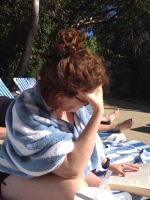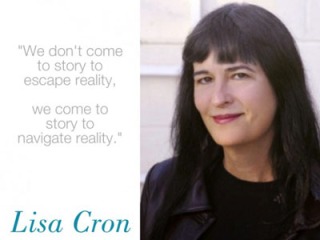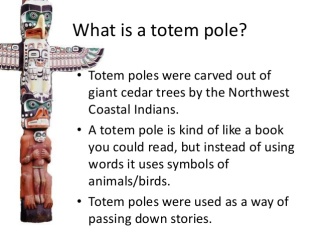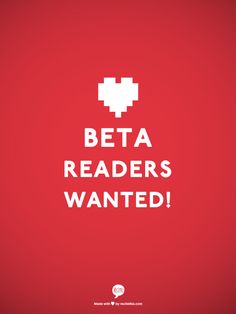I recently attended a writing conference for children’s books authors. The Iowa chapter of Society of Children’s Book Writers & Illustrators (SCBWI) held their annual conference in Cedar Rapids, Iowa this year.
You may wonder why I went to a children’s book conference. I don’t really write children’s books (but I might…), and I for sure am not and cannot illustrate a book of any kind! Why did I go?
 |
| Me and the brilliant Lisa Cron |
Two words: LISA CRON. Yes, MY writing guru, the chick that I get, the one who helped this novel writing business really click for me, Lisa Cron was the keynote speaker!
Lisa Cron is the author of Wired for Story and Story Genius. I’ve written a post about how I applied her theories from Story Genius to my first novel, THE INK OF TIME.
 |
| Courtesy of Google Images |
The first time I heard Lisa Cron she was being interviewed by JoAnna Penn, creator of The Creative Penn Podcast. When she talked about how the brain works and its/our biological need for stories I knew she was on to something. As a former teacher, I’ve put in many professional development and continuing education hours studying how the brain learns and/or why it doesn’t.
Besides The Creative Penn podcast interview, I’ve watched Ms. Cron give a TED Talk on the subject of brain science and its connection to story, I’ve read Story Genius one-and-a-half times*, and yet I still wanted to see the lady in person. I was not disappointed!
 |
| Right after being introduced 🙂 |
Ms. Lisa Cron can talk. Fast. She is passionate and knowledgeable about her topic and it shows. Lisa walked probably five miles in her first two-and-a-half hour presentation. She never stood still. Up and down the stage she walked. And she’s a ‘hand talker’, too. It was never a dull moment. I wrote so fast, only to be distracted by her animations, that my notes look like a battlefield! Good thing I’ve read the book!
This is some of what I’ve learned from her. These are the big points. Each one had many details about how to make them happen. Lots of writerly stuff.
1. The ability to write and the ability to tell a story are not the same. Events, quests, and a bunch of stuff happening is not a story. It’s a bunch of stuff happening.
2. All stories are about change, and change is hard. Stories allow us to experience something and learn from it. This makes me think of all the fables and tales that, throughout every culture, teach a lesson. Think about some of your favorite novels, what was its lesson or the cautionary tale? I think about the book (and movie) Girl on the Train, by Paula Hawkins. The obvious is ‘don’t be a drunk loser on a train’, right? But really, that book is about ‘trusting yourself and your instincts.’
 |
| One of many pictures Tim has taken of me while I’m reading. |
3. The first job of an effective story is to anesthetize the part of your brain that knows it’s a story, and puts you, the reader, IN the story. I so get that.
How many times have I been so deeply in a book that I don’t even hear other people talking to me? Lots and lots of times! Tim will tease me by saying, “The house is on fire!” That’s when I know he’s been trying to talk to me but I was oblivious. Does that ever happen to you? If so, you’ve struck story gold.
4. Story is not just entertainment. Stories tell us what to do, allow us to step out of the present and envision the future, and stories allow us to see the unknown and unexpected. (Remember, there is no such thing as “mindless entertainment.” You know the saying: “you are what you eat”? Same goes for entertainment. You may not even know how it affects you.)
So, every story worth its salt is created with these points in mind. Kinda makes writers pretty important, doesn’t it? Writers’ jobs are to give us food for thought. Something to contemplate. Something to learn from. Something to think about. Pretty big stuff, I say.
Then, THE INK OF TIME, right? Luckily, I already understood the concept of story being events that lead to a conclusion, so I didn’t have any actions or scene to delete because of that. However, the part about change was a big aha moment for me. Otto had a lot of stuff happen in his life that made him who he was at the beginning of this story. I wrote some pretty heart-breaking scenes with him and his sisters to illustrate that point. (Thanks again, Lisa Cron!)
I hope my readers (when I publish) will become engrossed in Otto’s story. One of the tricks is to tell very little about his physical appearance. This gives the reader the ability to step into his shoes. Also, the story is about a man who gets a job in a tattoo shop, but that just the vehicle, if you will, for the story. The overarching theme of my story is family. Who is family and what defines a family.
Think about what you read. Think about what a gift the author is giving to you – the opportunity to learn, experience, and explore. Big stuff.
 |
| And another picture of me reading! |
Until next time,
Be Good to Yourself.
~Nadine
*I will finish reading it for a second time, as part of my work on my second novel.







